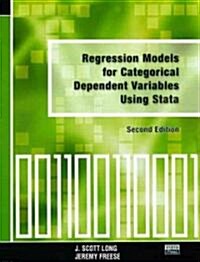
단행본
Regression models for categorical dependent variables using Stata
- 판사항
- 2nd ed
- 발행사항
- College Station, Tex: StataCorp LP, 2006
- 형태사항
- xxv, 527 p. : ill; 24cm
- ISBN
- 9781597180115
- 청구기호
- 413.8 L848r
- 서지주기
- Includes bibliographical references (p. [509]-514) and indexes
소장정보
| 위치 | 등록번호 | 청구기호 / 출력 | 상태 | 반납예정일 |
|---|---|---|---|---|
이용 가능 (1) | ||||
| 1자료실 | 00015087 | 대출가능 | - | |
이용 가능 (1)
- 등록번호
- 00015087
- 상태/반납예정일
- 대출가능
- -
- 위치/청구기호(출력)
- 1자료실
책 소개
Although regression models for categorical dependent variables are common, few texts explain how to interpret such models. Regression Models for Categorical Dependent Variables Using Stata, Second Edition, fills this void, showing how to fit and interpret regression models for categorical data with Stata. The authors also provide a suite of commands for hypothesis testing and model diagnostics to accompany the book.
The book begins with an excellent introduction to Stata and then provides a general treatment of estimation, testing, fit, and interpretation in this class of models. It covers in detail binary, ordinal, nominal, and count outcomes in separate chapters. The final chapter discusses how to fit and interpret models with special characteristics, such as ordinal and nominal independent variables, interaction, and nonlinear terms. One appendix discusses the syntax of the author-written commands, and a second gives details of the datasets used by the authors in the book.
Nearly 50% longer than the previous edition, the book covers new topics for fitting and interpreting models included in Stata 9, such as multinomial probit models, the stereotype logistic model, and zero-truncated count models. Many of the interpretation techniques have been updated to include interval as well as point estimates.
New to the Second Edition:
Regression models, including the zero-truncated Poisson and the zero-truncated negative binomial models, the hurdle model for counts, the stereotype logistic regression model, the rank-ordered logit model, and the multinomial probit model
Stata commands, such as estat, which provides a uniform way to access statistics useful for postestimation interpretation.
Expanded suite of programs known as SPost
Inclusion of confidence intervals for predictions computed by prvalue and prgen
Because all the examples, datasets, and author-written commands are available from the authors' Web site, readers can easily replicate the concrete examples using Stata, making it ideal for students or applied researchers who want to know how to fit and interpret models for categorical data.
The book begins with an excellent introduction to Stata and then provides a general treatment of estimation, testing, fit, and interpretation in this class of models. It covers in detail binary, ordinal, nominal, and count outcomes in separate chapters. The final chapter discusses how to fit and interpret models with special characteristics, such as ordinal and nominal independent variables, interaction, and nonlinear terms. One appendix discusses the syntax of the author-written commands, and a second gives details of the datasets used by the authors in the book.
Nearly 50% longer than the previous edition, the book covers new topics for fitting and interpreting models included in Stata 9, such as multinomial probit models, the stereotype logistic model, and zero-truncated count models. Many of the interpretation techniques have been updated to include interval as well as point estimates.
New to the Second Edition:
Because all the examples, datasets, and author-written commands are available from the authors' Web site, readers can easily replicate the concrete examples using Stata, making it ideal for students or applied researchers who want to know how to fit and interpret models for categorical data.
